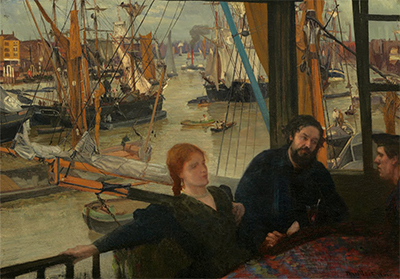The American artist James Abbott McNeill Whistler completed this painting of Wapping during his early time in London, while he was still using a figurative style.
Arriving in 1859, he was influenced by French poet Baudelaire to seek subjects among the working classes of the modern city, and chose to settle in the dockside district of Wapping, which teemed with river workers of all kinds. Living, eating and drinking amongst them enabled him to get a feel for the everyday life of working people at that time, and as an ex-topographer for the cartography department of the US Office of Coast Survey, he could produce skilled etchings that conveyed a sense of the busy Thames and its banks.
This picture of Wapping, however, is in oil, and unlike his later works, it is an exercise in realism, showig three figures on a balcony that looks out onto the Thames in Bermondsey. Although enhanced with the deep colours of oil paints, the canvas retains the sharp outlines of an etching, particularly in the portrayal of passing traffic in the background. The partial outline of the third person frames the picture, and helps to contain the action on the water, while also perhaps suggesting another life behind him.
Harmony of colour was essential to Whistler's art. He applied shades thinly, covering the canvas in multiple layers of paint, and increasing their intensity gradually. Figures would first be painted in dull brown, blending with the canvas, which would then see the background getting the same treatment. This process was much-repeated over time, until Whistler had coaxed the scene into life, giving it the sort of depth that is apparent in this depiction with its murky river and jostling boats.
Embracing the ideals of the Aesthetic Movement and its slogan Art for Art's Sake, his radical approach owes much to the Japanese style that was inspiring Western artists at the time, using flatter forms that would cause him to move gradually away from realism, and towards abstraction. For this, Whistler holds an important place in the history of art, between Impressionism and Post-Impressionism, changing the way that others, such as Manet and Degas, viewed their work. James Whistler also studied Velázquez, Rembrandt, and the sculptures of ancient Greece, and their influence is easy to see in this view of Wapping.




